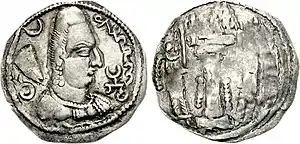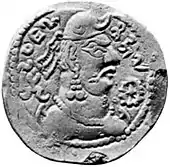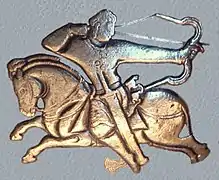Khingila I
Khingila I (Bactrian: ![]() χιγγιλο Khingilo, Brahmi script:
χιγγιλο Khingilo, Brahmi script:![]() Khi-ṇgi-la, Middle Chinese: 金吉剌 Jīnjílà, Persian: شنگل Shengil; c.430-490) was the founding king of the Hunnic Alkhan dynasty (Bactrian: αλχανο, Middle Chinese: 嚈噠). He was a contemporary of Khushnavaz (fl. 484).
Khi-ṇgi-la, Middle Chinese: 金吉剌 Jīnjílà, Persian: شنگل Shengil; c.430-490) was the founding king of the Hunnic Alkhan dynasty (Bactrian: αλχανο, Middle Chinese: 嚈噠). He was a contemporary of Khushnavaz (fl. 484).
| Khingila I | |
|---|---|
| Ruler of the Alchon Huns | |
 Portrait of king Khingila c. 440 - 490 CE on one of his silver drachms. Bactrian script legend: χιγγιλο αλχοννο "Khiggilo Alchono", with Alchon tamgha symbol  Approximate location of Khingila's territory | |
| Reign | 440-490 |
| Successor | Mehama |
| Born | c. 430 Central Asia |
| Died | c. 490 (aged 59–60) |
| Alchon Huns (400–670 CE) | |||||||||||||||||||||||||||||||||||||||
|---|---|---|---|---|---|---|---|---|---|---|---|---|---|---|---|---|---|---|---|---|---|---|---|---|---|---|---|---|---|---|---|---|---|---|---|---|---|---|---|
|
|||||||||||||||||||||||||||||||||||||||
Rule
In response to the migration of the Wusun (who were hard-pressed by the Rouran) from Zhetysu to the Pamir region, Khingila united the Uar and the Xionites in 460AD, establishing the Hepthalite dynasty.
According to the Syrian compilation of Church Historian Zacharias Rhetor (c. 465, Gaza – after 536), bishop of Mytilene, the need for new grazing land to replace that lost to the Wusun led Khingila's "Uar-Chionites" to displace the Sabirs to the west, who in turn displaced the Saragur, Ugor and Onogur, who then asked for an alliance and land from Byzantium.
In his coin in the Brahmi script, Khingila uses the legend "Deva Shahi Khingila" (![]()
![]()
![]()
![]()
![]() "God-King Khingila").[3]
"God-King Khingila").[3]
A "Seal of Khingila" is known, with legend in the Bactrian language, but it is uncertain if it belonged to Khingila, or another ruler of the same name.[4]
A Narendraditya Khinkhila, of the same ethnicity, is dated to the early 7th century CE.[3]
Artifacts
 Coin of younger Khingila, circa 440-490 CE.[5]
Coin of younger Khingila, circa 440-490 CE.[5] Khingila with the word "Alchono" in Bactrian script (αλχονο) and the Tamgha symbol on his coins.[6][7]
Khingila with the word "Alchono" in Bactrian script (αλχονο) and the Tamgha symbol on his coins.[6][7] Later coinage, with name "Khingila" in the Brahmi script.
Later coinage, with name "Khingila" in the Brahmi script.


 "Khingila" in Brahmi script on his later coinage
"Khingila" in Brahmi script on his later coinage
See also
References
- This coin is in the collection of the British Museum. For equivalent coin, see CNG Coins
- Rezakhani, Khodadad (2017). ReOrienting the Sasanians: East Iran in Late Antiquity. Edinburgh University Press. pp. 105–124. ISBN 9781474400305.
- Dhavalikar, M. K. (1971). "A Note on Two Gaṇeśa Statues from Afghanistan" (PDF). East and West. 21 (3/4): 331–336. ISSN 0012-8376.
- ALRAM, MICHAEL (2003). "Three Hunnic Bullae from Northwest India" (PDF). Bulletin of the Asia Institute. 17: 180, Figure 11. ISSN 0890-4464.
- CNG coins
- Rezakhani, Khodadad (2017). ReOrienting the Sasanians: East Iran in Late Antiquity. Edinburgh University Press. p. 199. ISBN 9781474400312.
- CNG Coins
- CNG Coins
- Bakker, Hans T. The Alkhan: A Hunnic People in South Asia. Barkhuis. pp. 43–47. ISBN 978-94-93194-00-7.